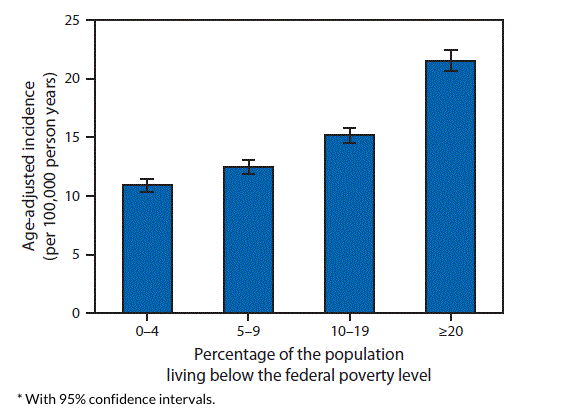Flu season can be a miserable slog no matter where you stand on the socioeconomic scale, but a new report shows that the virus hits poorer neighborhoods harder than wealthier ones.
The rate of flu-related hospitalization is two times higher in poorer neighborhoods than in richer ones, according to a report published last week by the Centers for Disease Control and Prevention. The researchers defined poorer neighborhoods as places where more than 20 percent of residents live below the poverty line, and wealthier ones as places where less than 5 percent of residents live in poverty.
The CDC looked at 27 million people across 14 different census tracts nationwide during the flu seasons spanning from 2010 to 2012. Researchers found that flu-related hospitalization rates for severe outcomes (which include intensive care, respiratory support and death) were consistently higher in poorer neighborhoods for whites, blacks, Asians and Latinos.

James Hadler, a clinical professor of epidemiology at the Yale School of Public Health who authored the analysis, said the results were "not a total surprise" but nonetheless important.
"People living in poor neighborhoods have a higher risk than people living in wealthy neighborhoods," Hadler said. He noted that while his analysis of neighborhood data "actually correlates fairly well with individual-level socioeconomic status," the findings address the collective risk to the neighborhood, not individuals.
But neighborhoods, he said, still have significant influence on a person's health.
"For something like influenza, the neighborhood factor could be that people are living in more crowded housing, living more than one person to a room on average, not leaving their neighborhoods much or neighborhood attitudes toward health," Halder said.
Access to health care is also a bigger challenge in poorer neighborhoods.
"If you’re a single parent, it might not be easy to take a number of children to an emergency room to be seen, or there may not be a health center in your neighborhood," Hadler said. "There might be a copayment you can’t make. Or poverty might prevent people from seeking treatment for chronic conditions like asthma,” which can make someone more susceptible to influenza-related complications.
Since the CDC doesn't commonly look at socioeconomic measures as part of its influenza surveillance, Hadler's analysis adds a valuable component to the data the center collects.
“It was nice to actually have data to confirm that people living in areas of high poverty experience more severe outcomes of the flu," said Joe Bresee, the chief of epidemiology in the CDC's influenza division.
Ideally, the data will help the CDC -- and in turn, state and local health agencies -- fine-tune their approach to making flu vaccines more accessible.
"The good thing abut the flu is that we know the best way to prevent it is vaccination. It’s a tool we use, and it’s underused," Bresee said.
Also on HuffPost:
